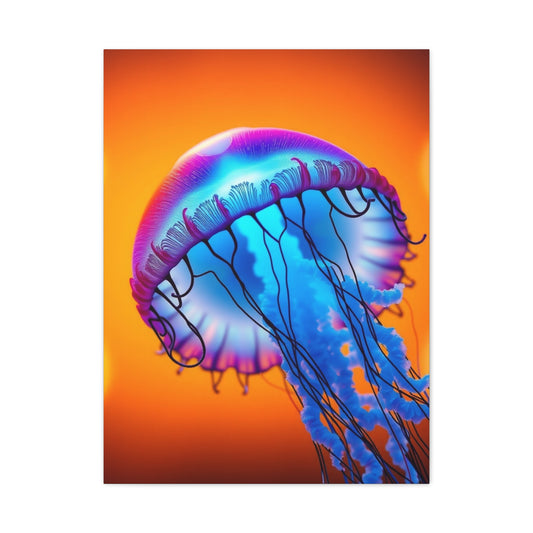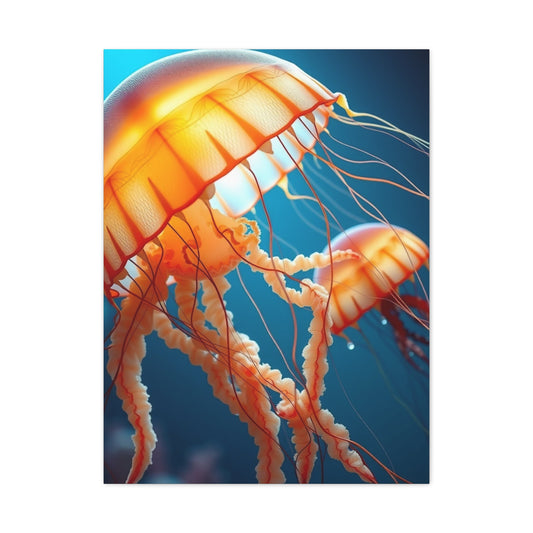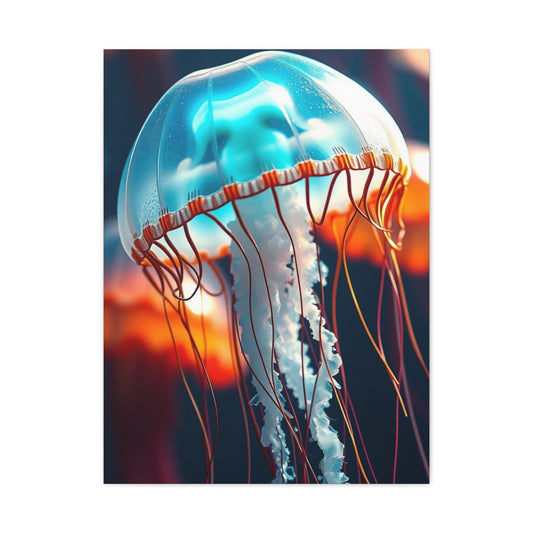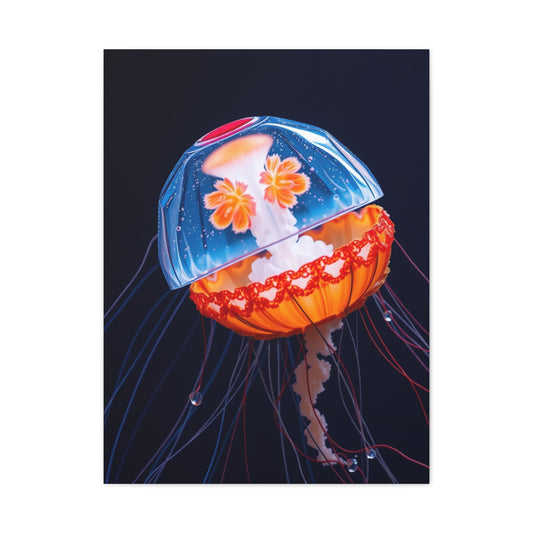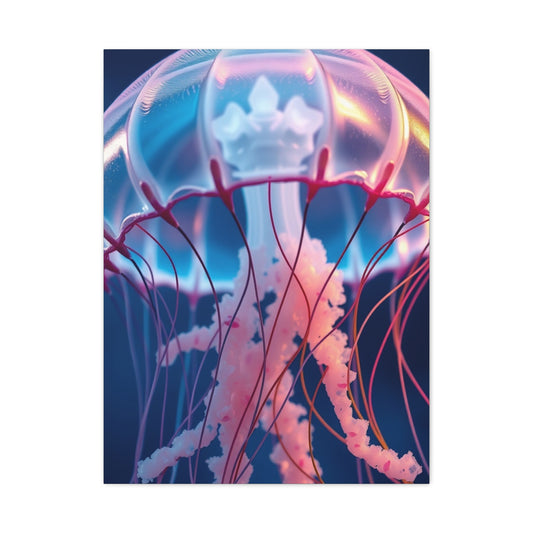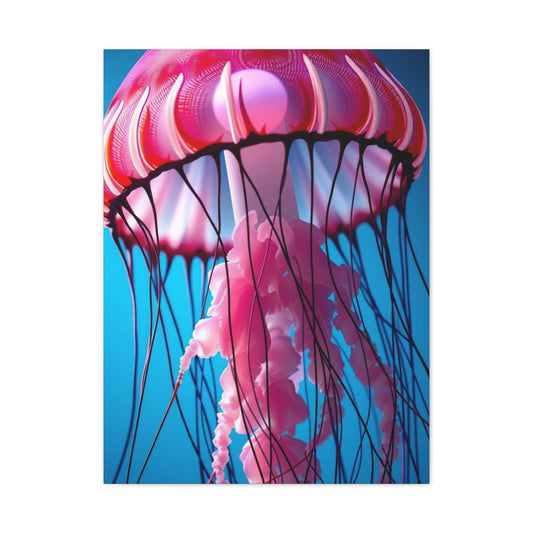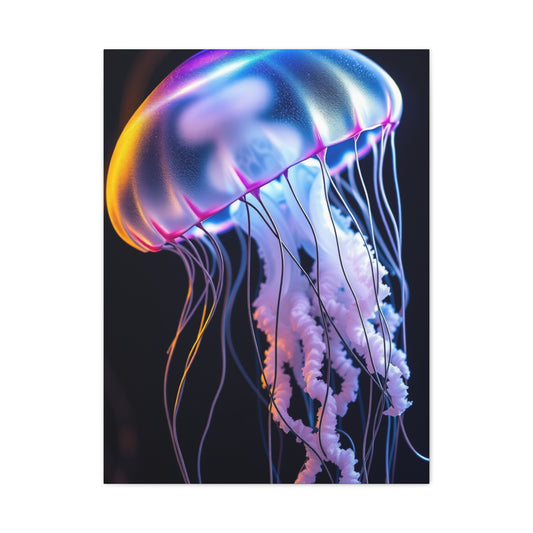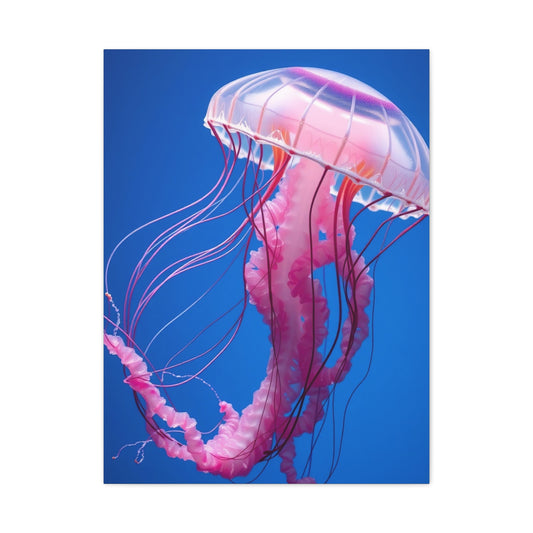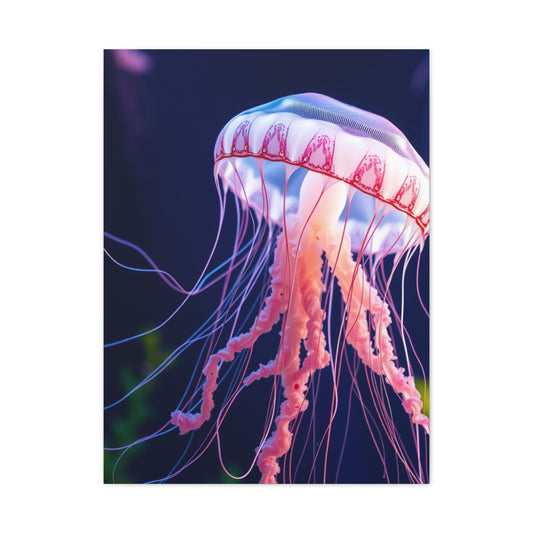Capturing Ocean Elegance Through Jellyfish Wall Art
Virginia Beach, with its sweeping Atlantic coastline, offers a lifestyle interwoven with both nature and culture. The ocean, a ceaseless expanse of undulating blues, is more than a geographic feature—it is a muse for artists, a sanctuary for residents, and a playground for those who seek outdoor adventure. Locals often indulge in hiking along coastal trails, fishing at dawn, skiing inland during winter months, and camping beneath starlit skies. This connection to the environment imbues daily life with a sense of rhythmic serenity and encourages an appreciation for aesthetics that mimic the fluidity and translucence of the sea.
Artistic expression in Virginia Beach is intrinsically tied to the ocean. The delicate, drifting forms of jellyfish, with their luminescent bodies and ethereal movements, encapsulate the essence of marine beauty. Capturing these creatures in wall art allows residents to evoke the calmness of the seaside within interiors, whether in a home, an office, or a communal dining space. Jellyfish wall art, from meticulous metal sculptures to ethereal canvas paintings, brings the pulsing energy of the ocean into living spaces, creating a bridge between the outdoors and indoor tranquility.
The visual impact of jellyfish art lies in its juxtaposition of fragility and resilience. Their translucent bells, accentuated by long, undulating tentacles, create a sense of ephemeral elegance that appeals to those who treasure unique and immersive décor. Residents of Virginia Beach, with their proximity to the Atlantic Ocean, often find that integrating such elements into their surroundings enhances their connection to the natural environment. The presence of jellyfish motifs is more than decorative; it is an invocation of the ocean’s rhythm, a reminder of its vastness, and an artistic nod to its ceaseless motion.
Integrating Marine Life into Interior Spaces
Translating the beauty of the ocean into interior décor is both an aesthetic and emotional endeavor. Jellyfish wall art serves as a medium through which the serenity and dynamism of the ocean can be experienced indoors. When choosing pieces for a living room, bedroom, or office, it is important to consider the scale, color palette, and materials to ensure the artwork complements the environment while evoking a sense of calm.
Canvas paintings depicting jellyfish often employ vibrant gradients of blues, purples, and translucent whites, mimicking the refracted sunlight underwater. These artworks can transform a bland wall into a focal point that draws the observer into an underwater narrative. By using high-quality canvas materials, the artwork gains a sense of depth and permanence, enhancing its visual impact. A deep-sea jellyfish painting, for instance, may feature a subtle interplay of shadow and illumination, creating an almost three-dimensional effect that suggests movement and life.
For those seeking a more tactile expression of marine aesthetics, metal jellyfish wall art offers a fusion of craftsmanship and imagination. These sculptural pieces, often handcrafted, emphasize contours and texture, capturing the undulating grace of jellyfish in a solid yet fluid form. The metallic sheen reflects ambient light, adding a dynamic interplay of shadows and highlights. Such sculptures provide a multifaceted sensory experience, inviting viewers to engage with the artwork both visually and spatially.
Beyond canvases and metalwork, vinyl decals and murals offer flexible, versatile ways to bring the ocean into everyday spaces. These decals often feature groups of jellyfish drifting through abstract seascapes or realistic coral environments. Their ease of application makes them suitable for walls, doors, cupboards, or even bathroom tiles, allowing homeowners to curate immersive environments without committing to permanent installations. The interplay of transparency, color, and placement can transform a room, creating a sensation of floating within an underwater world.
The Emotional Resonance of Jellyfish Imagery
Jellyfish wall art is not merely a decorative choice; it carries psychological and emotional resonance. The gentle, hypnotic motion of jellyfish can evoke calmness and introspection, fostering a meditative ambiance within a room. This is particularly valuable in high-traffic areas or spaces where relaxation and focus are desired, such as offices, study areas, or wellness corners in a home.
The natural bioluminescence of jellyfish, often rendered in fluorescent or luminous wall tapestries, adds an otherworldly charm to interiors. When paired with ambient lighting, these pieces create a sense of magic and curiosity, stimulating the imagination while retaining a grounding connection to marine life. In children’s rooms or nurseries, jellyfish decals inspire wonder and exploration, encouraging a fascination with the ocean and its creatures. The visual motifs offer more than aesthetics—they cultivate curiosity, learning, and a playful engagement with the natural world.
Living near the ocean, residents of Virginia Beach often seek to extend the sensory pleasures of their environment indoors. The rhythmic lapping of waves and the salt-laden breeze can be complemented by artistic representations of marine life, creating a holistic sensory experience. Jellyfish wall art, whether in a serene, monochromatic palette or a vibrant, psychedelic display, resonates with the innate human desire to harmonize with nature. Each piece becomes a portal to the ocean’s expanse, invoking serenity, contemplation, and a subtle reminder of the world beyond the walls.
Creative Applications and Placement
Selecting the right placement for jellyfish-themed décor is an integral part of creating an immersive experience. Large canvas paintings can dominate a central wall in a living room, dining area, or lobby, acting as a conversational focal point. Smaller prints or clusters of jellyfish decals can accentuate corners, hallways, or even staircases, offering moments of visual delight and continuity throughout a space.
In commercial spaces such as restaurants or boutique hotels, marine-themed décor can evoke a sophisticated coastal ambiance. The translucence and grace of jellyfish art harmonize with natural light, water features, and minimalist interior design to create a cohesive thematic environment. Metal sculptures, particularly when hung in groups or layered in dimensional displays, provide dynamic visual interest while reinforcing the oceanic narrative.
For personal spaces, versatility is key. Bathrooms, often underutilized for artistic expression, can become intimate underwater worlds with the addition of waterproof vinyl decals or mural installations. Children’s rooms benefit from playful, whimsical designs that spark imagination, while bedrooms and meditation areas can utilize canvas paintings or luminous tapestries to foster tranquility and reflection. By carefully considering scale, color, and material, homeowners can craft spaces that resonate emotionally and aesthetically with the fluidity of the ocean.
The Intersection of Nature and Design
Integrating jellyfish wall art into interior design is also an exploration of the intersection between natural science and creativity. Jellyfish, among the most ancient and enigmatic ocean dwellers, carry evolutionary significance and aesthetic intrigue. Their sinuous movements, delicate symmetry, and transparency inspire a diverse range of artistic interpretations—from hyperrealistic canvases to abstract, psychedelic tapestries.
In addition to their visual appeal, jellyfish motifs often embody themes of adaptability and resilience. Despite their apparent fragility, jellyfish have survived for millions of years, thriving in diverse oceanic conditions. Incorporating such imagery into interiors serves as a subtle metaphor for balance, flexibility, and endurance. The presence of these creatures within domestic or professional environments can encourage mindfulness and a heightened awareness of the natural rhythms that govern life.
The use of rare pigments, gradient techniques, and unconventional materials in jellyfish art also elevates interiors with a touch of rarity and distinction. Iridescent paints, metallic finishes, and translucent layers mimic the luminous quality of jellyfish, producing reflections and visual depth that change with light and perspective. Such sophisticated techniques ensure that each artwork is not merely an accessory but a signature element that defines the character and ambiance of the space.
The History and Symbolism of Jellyfish in Art
Throughout centuries, the ocean has served as a boundless source of inspiration for artists, philosophers, and storytellers. Among its myriad inhabitants, jellyfish stand out for their ethereal grace and enigmatic presence. Their delicate, almost spectral forms have been depicted in art, mythology, and literature, representing fluidity, impermanence, and the mysterious rhythms of the sea. Jellyfish symbolize adaptability, as they drift with ocean currents, embodying a balance between surrender and resilience.
In the realm of visual arts, jellyfish have appeared in various cultural interpretations, from traditional Japanese ink paintings to contemporary mixed-media installations. Their luminescent, translucent bodies invite artists to explore light, shadow, and transparency, producing captivating effects that echo the play of sunlight beneath the ocean’s surface. Modern wall art, including canvas paintings, metal sculptures, and vinyl decals, continues this tradition, translating the ocean’s poetry into tangible forms that enrich interiors.
By incorporating jellyfish imagery into home décor, individuals evoke a sense of timelessness and connection to natural cycles. The visual language of these creatures—undulating tentacles, bell-shaped bodies, and subtle luminosity—creates a sensory experience reminiscent of watching the ocean’s tides. In Virginia Beach, where residents are intimately familiar with the Atlantic Ocean’s ebb and flow, jellyfish wall art resonates deeply, merging environmental familiarity with artistic sophistication.
Choosing the Right Jellyfish Wall Art for Your Space
Selecting jellyfish wall art requires consideration of scale, medium, and ambience. Large-scale canvas paintings can serve as dramatic focal points in living rooms or communal areas, creating an immersive underwater narrative. These pieces often utilize gradations of cerulean, indigo, and pearlescent whites to simulate the depths and luminescence of ocean waters. The choice of high-quality canvas or stretched fabric enhances the artwork’s longevity and preserves intricate details of the jellyfish’s delicate anatomy.
Metal wall sculptures, on the other hand, offer a three-dimensional experience. Handcrafted from alloys such as brass or stainless steel, these pieces capture the undulating movements of jellyfish in a tactile and interactive form. The metallic sheen interacts with ambient light, producing dynamic shadows that shift with the viewer’s perspective. Such sculptures are especially effective in spaces that benefit from subtle movement and textural contrast, like offices, hallways, or open-concept living areas.
For more adaptable décor, vinyl wall decals and murals provide flexibility and ease of installation. These waterproof, removable designs allow for creative placement on walls, doors, furniture, and tiles. The transparent or semi-transparent qualities of some decals create a floating effect, enhancing the sense of depth in a room. Vinyl murals can also depict entire underwater ecosystems, allowing multiple jellyfish to drift among coral formations, creating a cohesive and immersive environment.
The Emotional and Psychological Impact of Marine-Themed Décor
Marine-themed décor, particularly jellyfish wall art, offers profound emotional and psychological benefits. The visual rhythm of floating jellyfish evokes calmness and introspection, making such décor ideal for meditation rooms, reading nooks, or spaces intended for relaxation. The soft, fluid lines of jellyfish provide a contrast to rigid architectural elements, balancing structural linearity with organic movement.
Bioluminescent or fluorescent jellyfish wall tapestries elevate this effect by introducing subtle, otherworldly illumination. When placed under ambient or blacklight conditions, these pieces produce a hypnotic glow reminiscent of deep-sea environments, creating an immersive sensory experience. Such artwork not only decorates but also transforms spaces, encouraging mindfulness and enhancing emotional well-being.
Children’s rooms benefit particularly from ocean-themed art. Jellyfish decals and murals stimulate curiosity and imagination, encouraging young minds to explore marine ecosystems. The combination of color, movement, and narrative potential fosters both educational and playful engagement, while providing a calming atmosphere that promotes focus and creativity.
Harmonizing Wall Art with Interior Design
Integrating jellyfish wall art effectively requires attention to spatial harmony, color coordination, and thematic consistency. For homes with neutral palettes, the vibrant blues, purples, and pearlescent tones of jellyfish paintings or decals can provide a striking focal point without overwhelming the space. In rooms featuring coastal or nautical themes, ocean-inspired art complements existing décor elements such as driftwood furniture, sandy hues, and oceanic textiles.
Placement is equally crucial. Large canvases can dominate a feature wall, while smaller decals can accentuate niches, corners, or stairwells. Groupings of metal sculptures create a sense of movement and interaction, particularly when mounted at varying heights. In commercial spaces, such as restaurants or boutique hotels, wall art can enhance thematic coherence, creating a seamless narrative that transports guests into a serene underwater environment.
The interplay between natural and artificial light also affects the perception of jellyfish art. Canvas paintings benefit from diffused, indirect lighting that highlights gradients and subtle details. Metal sculptures and luminous tapestries thrive under dynamic lighting, which emphasizes shadows, reflections, and glowing effects. By carefully calibrating lighting, homeowners and designers can maximize the immersive qualities of marine-themed décor.
Techniques and Materials in Contemporary Jellyfish Art
Modern jellyfish wall art employs a diverse array of techniques and materials to evoke the ocean’s textures, colors, and fluidity. Canvas paintings often utilize layering techniques, including glazes, washes, and brushstroke variations, to replicate the translucent qualities of jellyfish bells. Acrylics, oils, and watercolors allow artists to experiment with opacity and luminosity, producing artworks that appear to shimmer or float above the surface.
Metal sculptures leverage fabrication techniques such as laser cutting, embossing, and hand-forging to achieve intricate detailing. The interplay of curved metal sheets and polished finishes mimics the natural undulations of jellyfish tentacles. These three-dimensional pieces can be mounted individually or in clusters, creating dynamic displays that interact with ambient light.
Vinyl decals and murals utilize advanced printing technology to capture high-resolution imagery of jellyfish in motion. Transparent or semi-transparent backgrounds enhance the illusion of floating forms, while waterproof and removable materials ensure practicality and adaptability. Tapestries, particularly psychedelic or fluorescent variants, employ high-quality polyester or chiffon fabrics to achieve vibrant, long-lasting prints. These pieces can function as wall hangings, bedspreads, or decorative partitions, adding versatility to their visual impact.
Environmental Connection and Mindfulness
The presence of ocean-inspired wall art fosters a unique connection to the environment, even for those living far from the coast. Observing jellyfish artwork encourages mindfulness, inviting viewers to contemplate natural cycles, rhythms, and the delicate balance of ecosystems. The undulating movement of jellyfish and the translucence of their forms serve as visual meditations, reinforcing a sense of harmony and tranquility.
For Virginia Beach residents, the proximity to the Atlantic Ocean enhances this experience. The visual motifs of jellyfish evoke memories of tides, surf, and marine biodiversity. Indoor décor becomes a conduit for outdoor sensory experiences, integrating sound, sight, and spatial awareness into cohesive interior environments. Even in urban or inland settings, jellyfish art can recreate the calming effect of the ocean, providing a mental retreat within domestic or professional spaces.
Cultivating Unique Spaces with Jellyfish Wall Art
Incorporating jellyfish wall art allows individuals to cultivate spaces that are both visually compelling and emotionally enriching. By blending color, form, texture, and placement, homeowners can design interiors that reflect personal taste while resonating with the natural world. The versatility of jellyfish art—from delicate decals to luminous tapestries—offers options for every room and aesthetic preference.
Children’s rooms can benefit from playful and educational murals, while living rooms or offices may favor elegant canvas paintings or metal sculptures. Commercial spaces can integrate immersive décor to enhance customer experience, emphasizing the unique ambiance of an oceanic theme. By thoughtfully selecting materials and arrangements, jellyfish wall art becomes an integral element of interior design, contributing to both aesthetic appeal and emotional well-being.
Caring for Jellyfish Wall Art
Maintaining wall art ensures its longevity and preserves its visual impact. Regular dusting with soft cloths prevents the accumulation of particles that can dull colors or scratch surfaces. Canvas paintings benefit from avoiding direct exposure to moisture and sunlight, which can alter pigments over time. Metal sculptures require occasional polishing to maintain luster, while decals and vinyl murals should be applied to clean, dry surfaces for optimal adhesion.
Luminous tapestries and psychedelic designs should be handled carefully to prevent damage to prints. In children’s rooms or high-traffic areas, secure mounting and occasional rotation can prevent wear and maintain the visual integrity of the artwork. Proper care transforms wall art into a durable investment, allowing its beauty and emotional resonance to endure over years of display.
Exploring the Aesthetic Appeal of Jellyfish Wall Art
Jellyfish have long captivated the imagination with their translucent forms, flowing tentacles, and subtle luminescence. Unlike other marine creatures, their ethereal quality seems almost otherworldly, evoking both serenity and fascination. This makes them an exceptional subject for wall art, transforming ordinary spaces into immersive underwater realms. In interior décor, jellyfish motifs offer versatility, whether represented through canvas paintings, metal sculptures, or vinyl decals. Their aesthetic appeal lies not only in their visual beauty but also in the dynamic movement implied in their forms, which can create a sense of fluidity and depth in any environment.
The use of color in jellyfish art is particularly significant. Deep ocean blues, iridescent purples, and pearlescent whites are commonly employed to mirror the natural hues found beneath the waves. Some contemporary artists experiment with fluorescent or neon pigments, creating glowing effects reminiscent of bioluminescent jellyfish in the deep sea. Such color choices enhance the immersive quality of the artwork, making rooms feel expansive and evocative, while also providing a calming influence on observers.
Integrating Jellyfish Art into Various Spaces
The adaptability of jellyfish wall art allows it to complement a variety of interior settings. In living rooms, a large canvas depicting drifting jellyfish can serve as a statement piece, commanding attention while evoking tranquility. Smaller clusters of decals or prints can enhance hallways or staircases, offering visual continuity and a subtle nod to the fluidity of marine life. Bedrooms benefit from serene designs with muted tones, fostering a meditative atmosphere conducive to relaxation and sleep.
Bathrooms present a unique opportunity for immersive décor, particularly when using waterproof vinyl decals. These installations can transform mundane tiles into underwater vistas, with jellyfish appearing to drift gracefully across the walls. Such aquatic environments not only provide aesthetic pleasure but also evoke the sensory experience of being near the ocean, enhancing the connection between interior spaces and the natural world.
For commercial spaces, jellyfish-themed décor offers both sophistication and thematic coherence. Restaurants, cafes, and boutique hotels can utilize large-scale murals or sculptural installations to create a distinctive ambiance that engages patrons and encourages lingering. The fluidity of jellyfish imagery naturally complements coastal or nautical-themed interiors, while also adding a modern, artistic flair to spaces that prioritize aesthetics and customer experience.
The Emotional and Psychological Benefits of Jellyfish Wall Art
Beyond its visual appeal, jellyfish wall art carries significant emotional and psychological benefits. The gentle, flowing forms of jellyfish evoke calmness, mindfulness, and introspection, making them ideal for meditation rooms, offices, or quiet corners of a home. Observing their fluid movement—whether real or implied through artistic representation—can reduce stress, encourage reflection, and foster a sense of connection to the broader natural world.
In children’s rooms, jellyfish motifs provide both educational and imaginative value. Vinyl decals or murals depicting playful, colorful jellyfish can spark curiosity about marine life, encouraging young minds to explore and learn. The combination of movement, color, and form engages the senses, fostering cognitive development while creating a visually stimulating environment. Even luminous or fluorescent designs can serve as calming nightlights, blending aesthetics with functionality.
Materials and Techniques in Jellyfish Wall Art
Contemporary jellyfish art utilizes a variety of materials and techniques to capture the unique qualities of these marine creatures. Canvas paintings often employ layering methods, washes, and glazing techniques to recreate the translucent, flowing nature of jellyfish. Artists may use acrylics, oils, or watercolors, carefully blending shades to replicate the subtle luminosity and ethereal movement observed underwater.
Metal sculptures provide a contrasting, tactile approach. Handcrafted from materials such as stainless steel, aluminum, or brass, these pieces use curves, textures, and reflective finishes to simulate the delicate motion of jellyfish tentacles. Three-dimensional wall art creates depth and dynamism, with shadows and light interacting to enhance the sensory experience. Sculptures can be displayed individually or in clusters, forming a narrative that evokes the rhythm and grace of the ocean.
Vinyl decals and murals offer versatility and practicality. Transparent or semi-transparent designs create a floating effect, perfect for walls, doors, or furniture. Waterproof materials allow installation in high-moisture areas like bathrooms, while removable adhesive ensures easy repositioning or replacement. Psychedelic or fluorescent tapestries, often crafted from polyester or chiffon, introduce vibrant, immersive color palettes that react with ambient light to create otherworldly visual experiences.
Lighting and Placement Considerations
The placement of jellyfish wall art significantly influences its visual and emotional impact. Large canvases or tapestries work well as focal points in living rooms, dining areas, or office spaces, while smaller prints or decals can accentuate secondary walls, corners, or hallways. Layering multiple pieces at different heights creates movement and depth, enhancing the immersive effect of the artwork.
Lighting is another critical factor. Canvas paintings benefit from soft, diffused light to emphasize gradients and subtle details, while metal sculptures gain dynamism through directional or ambient lighting that casts shifting shadows. Fluorescent and luminous tapestries respond best to dim or colored lighting, creating an immersive, underwater ambiance. Thoughtful lighting enhances the perception of motion, transparency, and depth, elevating jellyfish art from a decorative element to a transformative experience.
Combining Jellyfish Art with Other Coastal Elements
To maximize the thematic impact of ocean-inspired décor, jellyfish wall art can be combined with other coastal elements. Textured textiles, driftwood furniture, seashell accents, and soft sandy hues complement the fluid, ethereal forms of jellyfish, creating a cohesive coastal aesthetic. This integration allows interiors to evoke the sensory richness of the ocean, from visual beauty to tactile and atmospheric cues.
Artwork depicting coral reefs, sea turtles, or schools of fish can be paired with jellyfish pieces to establish narrative continuity. Grouping different media, such as canvas paintings with metal sculptures or decals, provides variety while maintaining a cohesive underwater theme. This multidimensional approach enriches the visual experience and emphasizes the interconnectedness of marine life, echoing the complexity and diversity of ocean ecosystems.
The Cultural and Symbolic Significance of Jellyfish
Jellyfish hold symbolic meaning across various cultures. They are often associated with resilience, adaptability, and the delicate balance between vulnerability and strength. In art, jellyfish can represent the fleeting, ephemeral nature of life, their gentle movements suggesting patience, flexibility, and harmony with the environment. Incorporating jellyfish imagery into interiors thus provides not only aesthetic pleasure but also philosophical and contemplative value.
In modern design, jellyfish motifs are employed to evoke serenity and reflection. They serve as visual anchors that remind viewers of natural rhythms and cycles, fostering mindfulness and emotional balance. For residents of coastal regions, such as Virginia Beach, jellyfish wall art reinforces a connection to local ecosystems, evoking memories of tides, marine life, and the unique atmosphere of living by the ocean.
Maintaining and Caring for Jellyfish Wall Art
Proper care preserves the beauty and longevity of jellyfish wall art. Canvas paintings should be dusted regularly with soft, dry cloths and shielded from direct sunlight and moisture. Metal sculptures benefit from periodic cleaning and gentle polishing to maintain reflective surfaces and prevent oxidation. Vinyl decals and murals should be applied to clean, dry surfaces for optimal adhesion and can be removed carefully to avoid damage to the underlying walls.
Luminous tapestries, fluorescent prints, and fabric wall hangings require careful handling to prevent fading or fraying. Rotating or repositioning artwork can prevent wear in high-traffic areas and maintain the vibrancy of colors. Proper care ensures that these artistic elements continue to enrich interiors for years, offering both aesthetic pleasure and emotional resonance.
Creating Immersive Experiences Through Jellyfish Art
One of the most compelling aspects of jellyfish wall art is its ability to create immersive environments. By thoughtfully selecting medium, scale, placement, and lighting, homeowners can replicate the sensation of being underwater. This immersive quality encourages reflection, calmness, and engagement with the natural world, transforming interiors into experiences rather than mere functional spaces.
In communal areas, multiple pieces can be combined to form a cohesive visual journey. Small decals may lead the eye toward larger canvas paintings or sculptural installations, guiding viewers through an aquatic narrative. In personal spaces, a single, large luminous tapestry can evoke the tranquility of deep ocean waters, fostering introspection and mindfulness. The immersive potential of jellyfish art transcends decoration, creating a holistic sensory encounter.
Advanced Techniques in Jellyfish Wall Art
Jellyfish wall art has evolved far beyond traditional paintings, incorporating innovative techniques that enhance both visual appeal and spatial presence. Contemporary artists explore mixed media approaches, combining acrylics, oils, and resin to simulate the translucence of jellyfish bells and the delicate oscillation of their tentacles. Resin layering, in particular, allows for depth and luminosity, creating the illusion that jellyfish float above the surface of the canvas. Such techniques emphasize the ephemeral and fluid nature of these creatures, making them appear almost animated within static compositions.
Metal and sculptural interpretations employ cutting-edge fabrication methods. Laser-cut aluminum, hand-forged steel, and anodized metals allow for intricate detailing of tentacles and body contours. When installed on walls, these sculptures interact with ambient lighting to produce shifting shadows, adding a dynamic, almost kinetic element to the décor. By manipulating curvature and texture, artists can simulate the subtle movements of jellyfish drifting through water, offering an engaging and multisensory experience for viewers.
The Role of Scale and Proportion
Scale and proportion are crucial considerations when incorporating jellyfish art into interiors. Large canvases, murals, or installations dominate spaces, creating immersive focal points that draw attention and establish atmosphere. Oversized metal sculptures or clustered arrangements of wall decals can provide a sense of motion and rhythm, echoing the undulating flow of the ocean.
Smaller pieces, while subtler, offer versatility and continuity. Miniature canvas prints or vinyl decals can accentuate corners, stairways, or transitional areas, linking different spaces thematically. By carefully calibrating size and placement, designers can create a cohesive narrative that guides the viewer’s eye and fosters a sense of continuity, allowing the fluid forms of jellyfish to resonate throughout an environment.
Integrating Light and Color
Lighting is pivotal in enhancing the aesthetic and emotional impact of jellyfish wall art. Canvas paintings benefit from ambient, diffused light that highlights subtle gradients and layered textures. Metal sculptures respond dramatically to directional lighting, producing intricate shadows that shift with the viewer’s perspective, enhancing the illusion of movement.
Fluorescent or bioluminescent-inspired tapestries and wall hangings offer additional possibilities. When illuminated with low or colored lighting, these pieces create a luminous effect reminiscent of deep-sea jellyfish glowing in the dark. The interplay of light and color transforms ordinary spaces into immersive underwater experiences, evoking wonder and tranquility while providing a unique focal point.
Color selection is equally significant. Deep blues, aquamarines, and purples evoke oceanic depth, while pearlescent and translucent whites mimic natural luminescence. Vibrant neon hues or psychedelic interpretations can create playful, energetic environments, particularly suitable for children’s rooms, creative studios, or contemporary living spaces. The careful integration of light and color ensures that each piece maximizes its visual and emotional impact.
Functional Integration of Jellyfish Décor
Jellyfish wall art is not solely decorative; it can be seamlessly integrated into functional elements of interior design. For instance, wall-mounted shelves or storage units can incorporate jellyfish motifs, transforming everyday furnishings into artful expressions. Luminous tapestries can double as ambient lighting, while vinyl decals can delineate spaces, guide traffic flow, or highlight architectural features.
Even furniture can carry marine-inspired designs. Sideboards, room dividers, and bed frames featuring subtle jellyfish patterns reinforce the theme without overwhelming the environment. By blending aesthetic expression with functionality, interiors become cohesive ecosystems, where art and utility coexist harmoniously. This approach maximizes the immersive quality of jellyfish décor, ensuring both beauty and practicality.
Creating Layered and Multidimensional Spaces
One of the hallmarks of effective jellyfish décor is layering. Combining multiple forms of wall art—canvas paintings, metal sculptures, and vinyl decals—creates depth and dimensionality. Layered arrangements simulate the density and movement of jellyfish in their natural habitats, allowing viewers to perceive different planes and perspectives within the same space.
In commercial environments, layering can guide visual flow. A series of wall-mounted sculptures leading toward a mural or large canvas painting establishes a narrative journey, inviting engagement and discovery. In residential settings, smaller layered arrangements in hallways, staircases, or living rooms evoke a sense of continuous movement, connecting different areas thematically and enhancing the immersive experience of underwater life.
Emotional Resonance and Mindful Environments
Jellyfish wall art contributes not only to visual beauty but also to emotional and psychological well-being. The fluidity, translucence, and rhythmic movement inherent in jellyfish imagery evoke calmness, mindfulness, and introspection. Observers often find themselves drawn into the gentle undulations of the artwork, encouraging reflection and relaxation.
This is particularly valuable in spaces designed for contemplation or mental restoration. Meditation rooms, personal offices, and reading nooks benefit from the subtle serenity of jellyfish-themed décor, which promotes focus and reduces stress. The soft, flowing lines of jellyfish counterbalance rigid architectural forms, fostering harmony between structure and organic movement. Even in high-energy environments like restaurants or creative studios, jellyfish wall art can introduce moments of calm, providing balance and visual respite.
Educational and Experiential Value
Beyond aesthetics, jellyfish wall art can serve an educational purpose. Children and adults alike gain exposure to marine life, learning about the anatomy, movement, and ecological role of jellyfish through artistic representation. Murals depicting entire underwater ecosystems allow viewers to explore relationships between species, habitats, and oceanic processes.
Interactive or immersive installations further enhance experiential value. Luminous or motion-responsive jellyfish displays, for instance, engage viewers actively, transforming passive observation into a participatory experience. Such applications bridge art, education, and environmental awareness, fostering curiosity, empathy, and appreciation for marine biodiversity.
Customization and Personal Expression
Modern techniques in jellyfish wall art enable extensive customization, allowing individuals to tailor pieces to specific aesthetic, spatial, or thematic requirements. Canvas sizes, color schemes, and placement can be adapted to suit rooms of varying dimensions. Metal sculptures can be commissioned in bespoke configurations, creating unique focal points that reflect personal taste and interior style.
Vinyl decals and murals offer flexible arrangements, with elements that can be repositioned or layered to achieve desired effects. Fluorescent tapestries can be designed with custom color palettes or patterns, producing personalized visual narratives. This level of customization ensures that each installation is not only decorative but also a true expression of individual style and sensibility.
Combining Jellyfish Art with Natural Elements
Incorporating natural elements alongside jellyfish art enhances authenticity and emotional resonance. Driftwood frames, textured stones, and coral-inspired accents complement the ethereal qualities of jellyfish imagery, grounding abstract or luminous art in tangible materials. Such combinations create multisensory environments, where tactile, visual, and spatial cues converge to evoke the rhythm and tranquility of the ocean.
Water features, such as indoor fountains or reflective pools, further amplify the immersive experience. The interplay of real water with jellyfish-inspired décor simulates the natural habitat, enhancing realism and reinforcing thematic coherence. By blending art with natural materials and sensory elements, interiors become holistic environments that celebrate both aesthetic beauty and environmental connection.
Maintenance and Longevity
Preserving the integrity of jellyfish wall art requires careful maintenance. Canvas paintings should be protected from direct sunlight and moisture, and dusted gently to avoid abrasion. Metal sculptures benefit from occasional polishing and careful handling to maintain their sheen and prevent oxidation. Vinyl decals and murals require clean, dry surfaces for application, and should be removed carefully to prevent damage to the underlying walls.
Tapestries, particularly luminous or fluorescent ones, should be handled with care to prevent fading or wear. Rotating, repositioning, or periodically refreshing these pieces ensures longevity and sustained visual impact. Proper care preserves both aesthetic quality and emotional resonance, allowing jellyfish wall art to continue enriching interiors for years.
Contemporary Trends in Jellyfish Wall Art
The fascination with jellyfish in interior design has grown in recent years, driven by the desire for serene, immersive, and nature-inspired spaces. Contemporary trends favor multidimensional representations, combining realism with abstract interpretations. Artists experiment with glowing effects, layered textures, and dynamic compositions to create a sense of motion, depth, and ethereality. Psychedelic and fluorescent designs are increasingly popular, particularly in spaces that aim to captivate the imagination or evoke a sense of wonder.
Metal sculptures continue to rise in demand for their tactile and reflective qualities. Their interaction with natural and artificial light creates subtle shadow play, enhancing perception of movement. Meanwhile, murals and vinyl decals allow for scalable customization, enabling homeowners and designers to fill small nooks or entire walls with drifting jellyfish forms. These trends emphasize not only aesthetic appeal but also the immersive and emotional potential of wall art.
Integrating Jellyfish Art into Lifestyle
Beyond decoration, jellyfish wall art enriches lifestyle by promoting calmness, creativity, and mindfulness. In living spaces, observing jellyfish motifs can evoke a meditative state, reducing stress and encouraging reflection. The rhythmic forms and flowing lines encourage mental clarity, making such artwork ideal for meditation corners, study areas, or personal offices.
In children’s spaces, jellyfish art stimulates imagination and curiosity about marine ecosystems. Brightly colored decals, playful murals, and luminous tapestries transform bedrooms and play areas into underwater worlds, blending education with entertainment. This integration of art and learning fosters both cognitive and emotional development, while creating visually engaging environments that capture the fluidity and beauty of the ocean.
Restaurants, boutiques, and wellness centers also benefit from jellyfish-themed décor. The tranquil, aquatic imagery enhances ambiance, encouraging guests to relax and immerse themselves in the surroundings. By harmonizing with furniture, lighting, and architectural elements, jellyfish art contributes to thematic cohesion and memorable experiences, subtly shaping mood and perception within public spaces.
Creating Personalized Underwater Narratives
One of the most compelling aspects of jellyfish wall art is its capacity for personalization. Individuals can craft unique underwater narratives by selecting combinations of canvases, metal sculptures, decals, and tapestries. Layering multiple elements allows for a multidimensional approach, evoking the density and diversity of marine life.
Color, scale, and placement offer additional avenues for customization. Soft, muted tones may create a calming and meditative environment, while vibrant, fluorescent hues energize spaces and stimulate creativity. The careful orchestration of visual elements ensures that each installation aligns with personal taste, interior design, and spatial functionality. Personalized narratives turn walls into immersive experiences, transforming homes, offices, and commercial spaces into curated representations of the ocean’s wonder.
Balancing Aesthetic and Functional Design
Jellyfish wall art can seamlessly integrate with functional elements of interior design. Wall-mounted shelves, partitions, and furniture featuring jellyfish motifs blend practicality with artistry. Luminous tapestries may double as ambient lighting, while strategically placed decals guide movement through hallways or accentuate architectural features.
Incorporating functionality does not diminish aesthetic appeal; rather, it enhances the coherence of a space. Functional jellyfish-inspired décor reinforces thematic unity, allowing interiors to feel both visually captivating and purposefully designed. This balance between beauty and utility ensures that each piece contributes meaningfully to the environment, creating spaces that are aesthetically harmonious, emotionally engaging, and practically versatile.
Emotional and Sensory Engagement
Jellyfish wall art engages both emotion and senses, elevating interior spaces beyond visual decoration. The flowing, rhythmic forms of jellyfish evoke a calming, meditative atmosphere. Observers often experience a sense of weightlessness or gentle movement, reminiscent of the ocean’s undulating currents.
Sensory engagement is further amplified through light, texture, and material. Metal sculptures produce reflective patterns, canvas paintings capture gradients and depth, and luminous tapestries evoke soft illumination. Vinyl decals create spatial illusions, adding dimension and perspective to walls. These elements work together to create immersive environments that encourage mindfulness, reflection, and emotional balance, reinforcing the intrinsic connection between humans and nature.
Designing for Cohesion and Flow
Effective use of jellyfish wall art requires attention to spatial cohesion and visual flow. Large murals or installations can dominate a central wall, while smaller decals and prints accentuate secondary areas. Layering elements at varying heights and distances creates a sense of depth, guiding the viewer’s gaze through the space and enhancing thematic continuity.
Color and texture coordination further reinforces cohesion. Blues, purples, and pearlescent tones harmonize with coastal or neutral palettes, while metallic accents and reflective surfaces introduce sophistication. Thoughtful composition ensures that the aesthetic impact is balanced, allowing each piece to contribute to the overarching narrative without overwhelming the room.
Enhancing Wellness Through Jellyfish Décor
The calming qualities of jellyfish imagery extend beyond aesthetics, offering wellness benefits for interior spaces. Observing fluid forms and soft, undulating motion can lower stress levels and encourage mental clarity. In offices, meditation rooms, or wellness centers, jellyfish-inspired décor supports focus, relaxation, and mindfulness practices.
Children and adults alike benefit from exposure to marine-themed environments. Educational murals foster curiosity and learning, while luminous tapestries or subtle wall decals create serene atmospheres conducive to concentration and reflection. By integrating jellyfish art, interiors become environments that nurture both the mind and spirit, promoting holistic wellness alongside visual enrichment.
Preservation and Care
Maintaining jellyfish wall art ensures its longevity and sustained impact. Canvas paintings should be dusted regularly and shielded from direct sunlight and moisture. Metal sculptures benefit from occasional polishing to preserve reflective surfaces and prevent corrosion. Vinyl decals and murals require clean, dry surfaces for application, and careful removal prevents damage to walls or surfaces.
Tapestries and luminous prints should be handled gently, avoiding excessive friction or exposure to harsh light. Rotating or repositioning artwork can prevent wear in high-traffic areas and maintain the vibrancy of colors. Proper care allows jellyfish wall art to remain visually striking and emotionally resonant for years, preserving both aesthetic and functional value.
Inspiring Connection to the Ocean
One of the most profound aspects of jellyfish wall art is its ability to foster a connection to the ocean. For residents near coastal areas, such as Virginia Beach, these artworks evoke familiarity with tides, waves, and marine ecosystems. Even for those far from the sea, the presence of jellyfish imagery creates a symbolic bridge to nature, instilling a sense of wonder, tranquility, and appreciation for aquatic life.
Integrating jellyfish art into interiors encourages observation, reflection, and contemplation. It provides a visual cue for mindfulness, while simultaneously serving as a reminder of the vastness, beauty, and complexity of the natural world. By invoking both familiarity and imagination, jellyfish wall art transforms everyday spaces into portals to the serenity and mystery of the ocean.
Conclusion
Jellyfish wall art embodies the perfect fusion of natural elegance, artistic expression, and interior design versatility. From luminous tapestries and intricate canvas paintings to sculptural metal pieces and flexible vinyl decals, these artworks transform ordinary spaces into immersive underwater experiences. Their flowing forms, subtle luminescence, and graceful movement evoke calmness, curiosity, and mindfulness, enriching both residential and commercial interiors.
Beyond aesthetics, jellyfish art fosters emotional connection and wellness, encouraging reflection, focus, and imaginative exploration. It allows individuals to bring the ocean’s serenity indoors, whether through large statement pieces or layered, multidimensional arrangements. Thoughtful placement, lighting, and complementary décor maximize the impact, while careful maintenance ensures longevity and continued visual appeal.
Ultimately, jellyfish wall art celebrates the beauty and mystery of marine life, bridging nature and human creativity. It is more than decoration—it is an invitation to experience the ocean’s rhythm, tranquility, and wonder every day.

